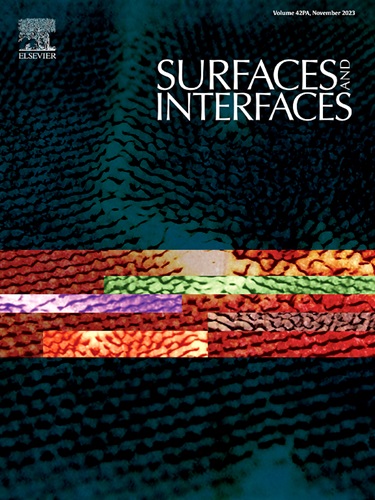Eco-friendly and highly efficient rust removal for Q235 steel via UV-induced copolymerization of acrylic monomers into adsorptive gel
IF 5.7
2区 材料科学
Q2 CHEMISTRY, PHYSICAL
引用次数: 0
Abstract
Metal corrosion and rusting have caused significant losses to humans, and environmentally friendly and efficient rust removal methods are receiving increasing attention. Here, we propose a method for rust removal by synthesizing acrylic gel on Q235 steel sheet using a photopolymerization reaction. The weak acidity of acrylic acid decomposes rust, and the gel formed by the reaction of acrylic acid with acrylamide has strong adsorption capacity, which effectively adsorbs rust molecules and metal ions. The introduced Cu2O enhances the rust removal system. Cu2O reacts with the acrylic acid monomer to form a monovalent copper complex, which can improve the rust removal efficiency during the process through redox reactions. The UV-induced copolymerization of acrylic monomers to form gel enables effective rust removal, with a rust removal rate as high as 85.94 g·h–1·m–2. This method avoids the use of strong acids commonly found in traditional rust removal methods, offering advantages such as environmental friendliness and low cost. The gel formed during the rust removal process can be easily and conveniently removed from the substrate surface, thus avoiding secondary pollution issues such as waste liquid disposal.

金属腐蚀和生锈给人类造成了重大损失,环保高效的除锈方法越来越受到人们的关注。在此,我们提出了一种利用光聚合反应在 Q235 钢板上合成丙烯酸凝胶的除锈方法。丙烯酸的弱酸性可分解铁锈,丙烯酸与丙烯酰胺反应形成的凝胶具有很强的吸附能力,可有效吸附铁锈分子和金属离子。引入的 Cu2O 可增强除锈系统。Cu2O 与丙烯酸单体反应生成一价铜络合物,通过氧化还原反应提高除锈效率。紫外线诱导丙烯酸单体共聚形成凝胶,可有效除锈,除锈率高达 85.94 g-h-1-m-2。这种方法避免了使用传统除锈方法中常见的强酸,具有环保和成本低等优点。除锈过程中形成的凝胶可以轻松方便地从基材表面清除,从而避免了废液处理等二次污染问题。
本文章由计算机程序翻译,如有差异,请以英文原文为准。
求助全文
约1分钟内获得全文
求助全文
来源期刊

Surfaces and Interfaces
Chemistry-General Chemistry
CiteScore
8.50
自引率
6.50%
发文量
753
审稿时长
35 days
期刊介绍:
The aim of the journal is to provide a respectful outlet for ''sound science'' papers in all research areas on surfaces and interfaces. We define sound science papers as papers that describe new and well-executed research, but that do not necessarily provide brand new insights or are merely a description of research results.
Surfaces and Interfaces publishes research papers in all fields of surface science which may not always find the right home on first submission to our Elsevier sister journals (Applied Surface, Surface and Coatings Technology, Thin Solid Films)
 求助内容:
求助内容: 应助结果提醒方式:
应助结果提醒方式:


